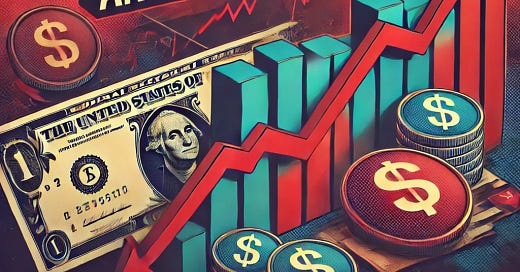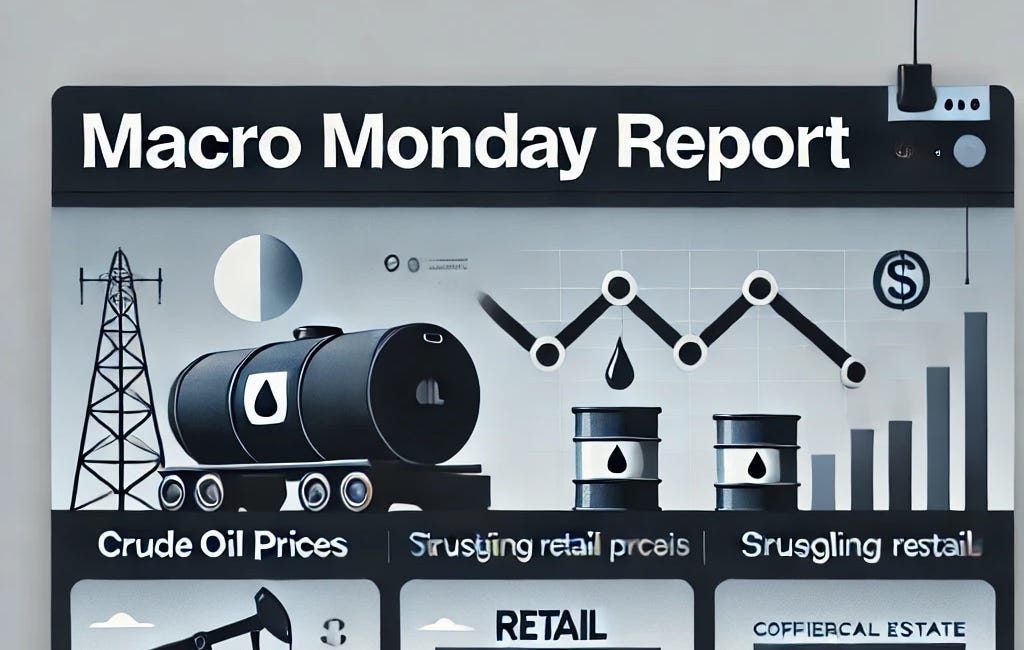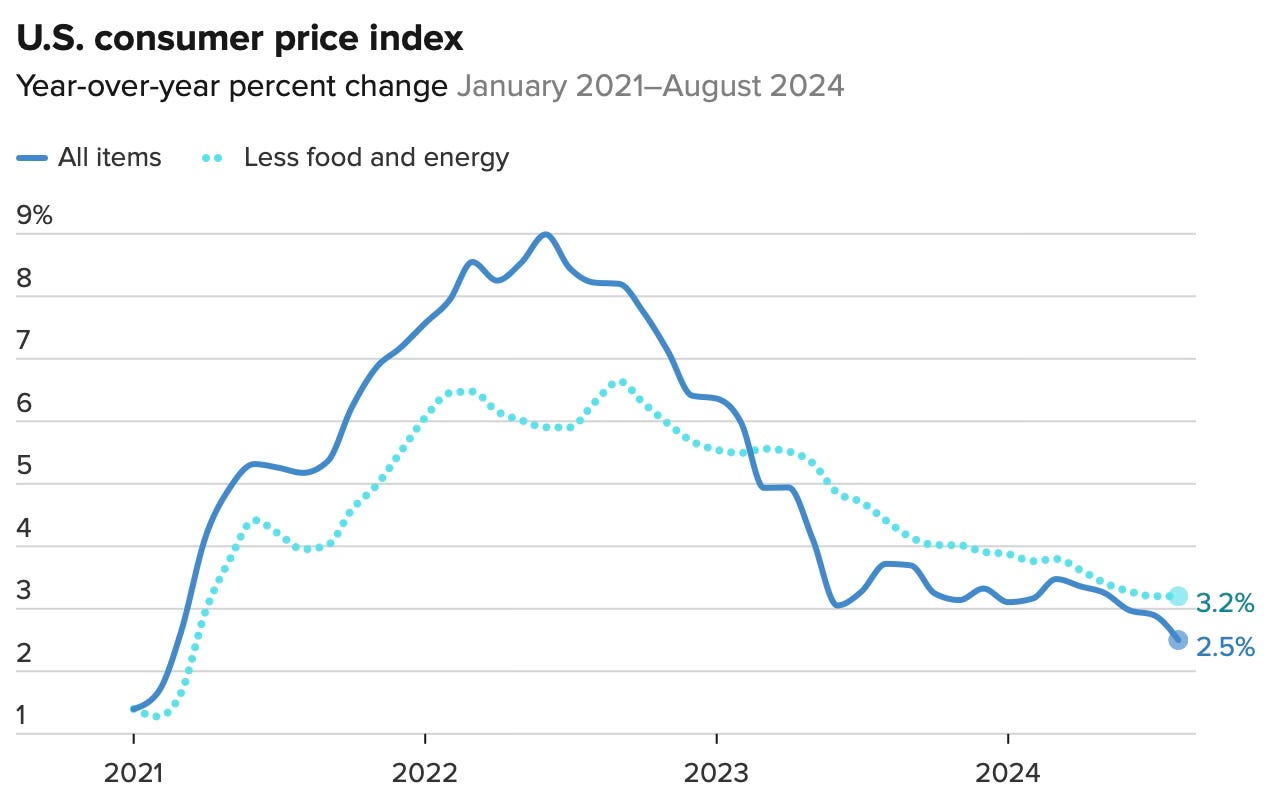Stagflation on the Horizon? Jamie Dimon's Warning & What It Means for Your Investments
Is Stagflation Coming? Jamie Dimon thinks so. Understanding the risks and opportunities that you can take advantage of today.
Welcome to Macro Monday where I dive into some macro economy headlines and discussions.
This week I have some headlines that crossed over the past week, and then a deeper discussion on stagflation - which Jamie Dimon (CEO of JP Morgan) said could be on the horizon.
I’ll discuss what stagflation is, and the types of investments that I’m targeting just in case Mr. Dimon is correct.
Let’s get into it.
Amazon Ditches Work From Home
Last week we discussed commercial real estate vacancy rates. You can read the full post below:
Retail Woes, Oil Slump, and Real Estate Risks - This Week’s Macro Insights
Happy Monday if that’s a thing. Every Monday here on the newsletter expect a Macro Monday Report.
Well … one way to boost commercial real estate will be for large companies to bring employees back to the office.
Amazon announced all employees back to the office for 5 days per week. Previously Amazon allowed 3 days per week office work. Employees will have until January 2, 2025 to adhere to the new policy.
My initial reaction is this is a great way for Amazon to shed some employees without having to fire them. CEO Andy Jassey has been very good (in my opinion) making Amazon much more profitable than under Jeff Bezos, and this is likely a continuation of that.
More companies are moving “back to the office” and that’s a trend to follow closely as the commercial real estate sector would stand to benefit.
Lots of Layoffs
Several companies announced layoffs this week, here are just a few that I could find:
After laying off 12,000 workers earlier this year UPS UPS 0.00%↑ announced it is laying more workers in order to boost profits.
Samsung is rumored to be reducing its global workforce by about 30%.
PricewaterhouseCoopers is laying off about 1,800 workers in the US. Notable because this is the first time the company has cut positions since the great financial crisis.
Microsoft MSFT 0.00%↑ cut 650 jobs from its XBOX division.
Verizon VZ 0.00%↑ announced a $1.9B restructuring charge tied to 4,800 job cuts.
Boeing BA 0.00%↑ announced a hiring freeze to preserve cash.
On the bright side Target TGT 0.00%↑ announced hiring of 100,000 season workers which is similar to the numbers from last year.
Anecdotally I have many friends and former colleague across many industries that are struggling to find work. Companies that used to be hiring almost anyone are starting to vanish. We’ll discuss the unemployment rate a bit later, but the layoff headlines are a leading indicator of where the job market is heading … and it’s not good.
Stagflation?
JP Morgan JPM 0.00%↑ CEO Jamie Dimon said last week that he’s not ruling out stagflation … which is his worst case outcome for the US Economy.
He cites higher government (deficit) spending on infrastructure.
Here’s what you need to know about Stagflation:
Inflation rate is high or increasing
Economic growth rate slows
Unemployment remains steadily high
Let examine each of the 3 parts individually to see if Jamie Dimon has a point.
On the inflation front, last Wednesday, we received the highly anticipated August Consumer Price Index (CPI) report.
The key highlights from the August CPI report are as follows:
The overall increase in CPI over the last 12 months was 2.5%, down from 2.9% in the prior month.
On a month-over-month basis, the CPI increased by 0.2%.
Core CPI (excludes food & energy) increased 0.3% month over month.
As you can see, the inflation rate has certainly fallen from the highs seen around 2 years ago - but a 2.5% increase is still above the Federal Reserve's 2% target rate of inflation.
From a stagflation perspective a 2.5% CPI can check the box of a “high” inflation rate if the rate doesn’t continue to move down.
And even if the rate were to moderately head lower, the other aspects of stagflation can have a bigger impact on the stock market.
The next required ingredient for stagflation would be slowing economic growth rates.
General consensus is that the economy is going to slow as we head into the end of 2024.
Personal saving rates have fallen from pandemic stimulus fueled highs. In fact the reading is now below the rates we saw before the pandemic even began.
The impact of higher inflation and higher interest rates are starting to take their toll on the consumer, and it’s not likely we see an immediate recovery.
Time will certainly be the judge, but most signs point to a slowing economy. Much of that is based on the job market.
The final nail for a stagflation environment would be unemployment rates remaining steadily high.
Last month the Sahm rule was triggered.
What is the Sahm Rule?
Named after economist Claudia Sahm, this rule has proven to be a reliable indicator of the onset of recessions.
Here's how it works:
A recession is likely underway when:
The 3-month moving average of the U.S. unemployment rate rises at least 0.5 percentage points (50 basis points) above its lowest point in the previous 12 months.
The power of this rule lies in its simplicity and its track record. To date, the Sahm Rule has accurately signaled the beginning of every recession since the 1970s, without any false positives.
So while the unemployment rate isn’t exactly “high” - the fact it’s risen well above its 3-month moving average is a huge cause for concern.
So what does this all mean?
Well … the economy is on shaky ground.
All the ingredients for stagflation (high inflation, high unemployment and slow GDP growth) are essentially here. It’s now just a matter of how long they last.
The Federal Reserve signaling a rate cut is the indication you need that they feel the real economy is suffering - and it might get worse.
The Federal Reserve will try and do its part by lowering interest rates later this year - but it’s possible that will be too little too late.
But let’s not curl up in a ball and be scared. Times of economic distress are when investors make life changing money.
In a stagflation environment there’s going to be opportunities.
As usual, it depends on your age and risk tolerance.
If you’re older - and don’t have time to see your retirement account experience a draw down in value, these are times where a slightly more conservative approach is wise.
Consumers will pull back on discretionary spending. Think: travel, new cars, and non essential items. Most of the data is indicating this is already happening.
At some point we’ll revisit the discretionary sector - as the names will be beaten down so much that the recovery will uncover many investment possibilities.
Names like Lululemon LULU 0.00%↑ Nike NKE 0.00%↑ and Tesla TSLA 0.00%↑ have lagged the performance of nearly every benchmark … but pure discretionary stocks like this will flourish once the consumer is feeling a bit more confident.
This newsletter will cover these opportunities heavily once the time is right.
However, consumers won’t pull back on staple items sold at stores like Walmart WMT 0.00%↑ Target TGT 0.00%↑ and Costco COST 0.00%↑
In fact, these companies have reported well above average earnings as consumers are relying on the value proposition they provide.
It’s reflected in the stocks performance as well. Walmart shares, for example, are up over 50% this year. Over the past year Costco shares are up over 60% and its stock trades at a higher Price-to-Earnings multiple than Nvidia! NVDA 0.00%↑
Also consider Warren Buffett’s Berkshire Hathaway (BRK.B) business. Yes, the core business of energy, railroads and insurance would see a slowdown - however it would be offset by the $200B+ cash pile for Buffett and his team to invest.
You probably saw that Mr. Buffett - known for his “buy and hold” mentality recently sold significant portions of his Apple AAPL 0.00%↑ and Bank of America BAC 0.00%↑ stakes.
Older investors should take a cue from Warren Buffett and move to the sidelines. Wait for the dust to settle. If Jamie Dimon is correct and stagflation hits, that will send stocks much lower - even with the Federal Reserve lowering interest rates.
Conclusion
As always there’s no “one size fits all” investment approach.
If I was managing clients portfolios and wealth, here’s what I would be doing:
I’d start by trimming (selling) around the edges of the portfolio.
What that means is you should have a group of core positions in your portfolio. For some of you it could be some ETFs or Mutual Funds that you’ve accumulated over the years in an IRA or 401K account.
If it’s a broad based S&P 500 type fund - I’d continue to hold.
The edges of your portfolio are all the speculative buys you might have made over the past few months or years.
Let’s face it, small caps and speculative stocks have had a great run as the Federal Reserve rate cut is seen as benefiting that group of stocks the most.
However, the Federal Reserve cutting rates doesn’t solve a weak economy … in fact, it signals that a weak economy is here.
I don’t particularly like unprofitable companies in a stagflationary environment.
I know newsletter writers that are actively recommending biotech and speculative penny stocks.
The time to do that was at least 6 - 12 months ago. As usual, most are a step behind.
Instead I’d focus on profitable companies with large cash piles.
If we see a real meaningful slowdown in the economy - it will be the companies with large cash piles that will put it to work, whereas the unprofitable small cap stock will be on its knees at a bank looking for a loan just to get by.
Lastly, don’t be nervous about a weakening economy. Fear based titles and topics do great for getting attention - and I’m guilty of using them on YouTube and content.
The reality is, savvy investors like yourself will build an Empire during these times.
As the economic data rolls in, I’ll keep you updated. And as always, thanks for reading and I’ll see you again later this week.
Colin Tedards






